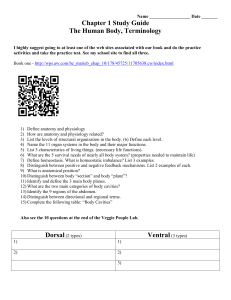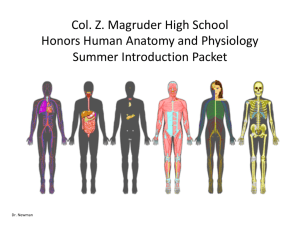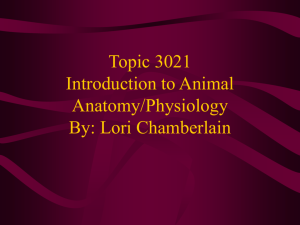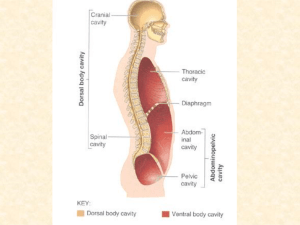Bio II Intro Teacher Notes
advertisement
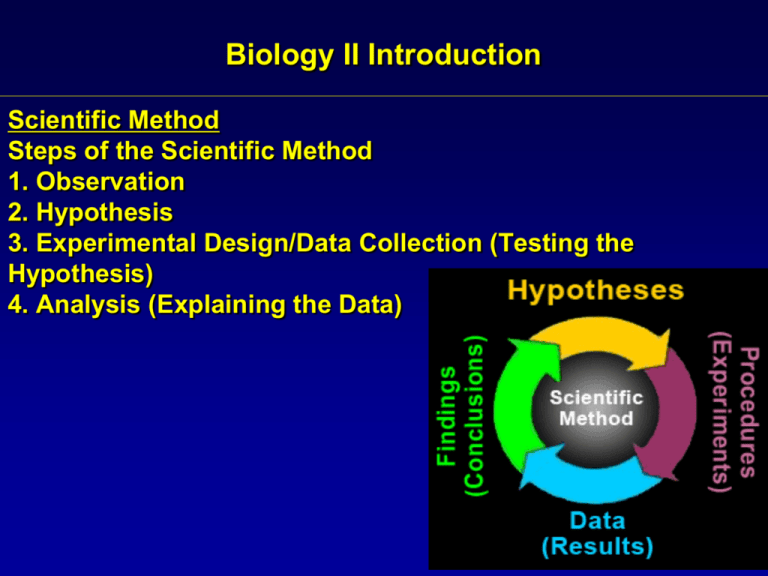
Biology II Introduction Scientific Method Steps of the Scientific Method 1. Observation 2. Hypothesis 3. Experimental Design/Data Collection (Testing the Hypothesis) 4. Analysis (Explaining the Data) Important Scientific Method Terms -Control Factor in an experiment that stays the same throughout the course of the experiment. All good experiments have at least one control -Variable Factor in the experiment changes. The fewer the variables in an experiment, the better the design. -Theory Hypothesis that is tested repeatedly and never disproved Anatomy & Physiology Introduction Anatomy – study of anatomical features or structures Physiology- study of biological functions Anatomy & Physiology are linked because form follows function Example: HeartVentricles of heart consist of fibrous muscle These muscles are used expel blood from the heart to the rest of the body TeethMolars are flattened; used for grinding food Canines & incisors are sharp; used for tearing and cutting food Teeth Levels of Structure and Organization in the Body Level Example Atom Hydrogen, Chlorine Molecule Water, Glucose Macromolecule DNA, Protein Organelle Ribosomes, Nucleus Cell Neuron, Muscle cell Tissue Connective Tissue Organ Skin, Liver Organ System Digestive System Organism Human, Narwhale Properties Of Life 1. Made of cells 2. Reproduction 3. Universal genetic code 4. Growth and development Growth- Increase in Amount of material in an organism Development- Series of changes an organism undergoes in becoming an adult 5. Obtain & use energy (from food or sun) 6. Respond to their environment Stimulus: anything in an organism’s environment that causes it to react 7. Homeostasis: Organisms maintain constant internal conditions regardless of external changes Examples? 8. Evolve: Species change over time Requirements for Organisms Water- used for metabolic processes; transport of molecules, regulation of body temperature Food- provide nutrients and energy; raw materials for building new molecules Oxygen- Used to release energy from nutrients; drives metabolism Heat- Increases the rate of chemical reactions in the body Pressure- application of a force on an object; aids in breathing (atmospheric pressure) and transport (blood pressure) Homeostasis and Feedback Loops The stabilization of internal conditions is governed by 3 components -Receptors = cells or parts of cells that provide information about the body’s internal environment -Control Center = usually Brain of CNS. Tells the body what the internal environment should be -Effectors = muscles or glands that alter the conditions of the internal environment Negative Feedback Loop Receptors measure a deviation from the norm, control center registers the deviation, and effectors return the condition to normal. Example: Body temperature, blood pressure & blood glucose (book page 12) Organization of the Human Body Axial Portion Head and Trunk Appendicular Portion Arms and Legs Body Cavities Dorsal Cavity Cranial and Vertebral Cavities Ventral Cavity Abdomen, Thoracic, and Pelvic Cavities Cavity Membranes Serous Membranes Line each cavity and hold organs in place Examples: Pleural Membranes Line the Lungs Pericardial Membrane Lines the Heart Peritoneal Membrane Lines the Abdominal cavity Directional Terms Superior toward the head or upper part of the body Example: The heart is superior to the liver Inferior Away from the head, toward the lower part of the body Example: The stomach is inferior to the lungs Anterior toward the front of the body; a body lying in the prone position has its anterior side down. In the supine position it is anterior side is up Example The sternum is anterior to the heart Posterior Toward the back of the body Example: The esophagus is posterior to the trachea Medial Nearer to the midline of the body. The midline is an imaginary vertical line that divides the body into left and right halves Example: The heart is medial to the scapula Lateral Farther from the midline of the body Example: The lungs are lateral to the heart Intermediate Between 2 structures Example: Your middle finger is intermediate to your index and ring finger Directional Terms Ipsilateral On the same side of the body Example: The appendix and small intestine are ipsilateral Contralateral On the opposite sides of the body Example: The large intestine and small intestine are contralateral Proximal Nearer to the trunk of the body; nearer Example: The humerus is proximal to the radius Distal Farther from the trunk of the body; farther away Example: The phalanges are distal to the carpals (wrist bones) Superficial Toward the surface of the body Example: The sternum is superficial to the heart Visceral Toward the inside of the body Example: The ribs are visceral to the skin Parietal Forming the outer wall of a body cavity Example The parietal pleura from the external surface of the lungs Divisions of the Body Sagittal Plane Vertically divides the body into 2 parts; left and right Frontal PlaneDivides the body into 2 parts; anterior and posterior Transverse Plane Divides the body from top to bottom; superior (cranial) to inferior (caudal) Anatomy & Physiology Subdivisions •Gross Anatomy Study of structures that can be seen without a microscope •Systemic Anatomy Study of specific systems •Radiographic Anatomy Study of structures using X-rays •Developmental Anatomy Study of zygotes to adults •Embryology Study of zygote to 8th week in utero •Histology Study of tissues •Cytology Study of cells •Pathological Anatomy Study of structural changes associated with disease •Pathophysiology Study of functional changes associated with disease •Neurophysiology Study of the function of nerve cells •Endocrinology Study of hormone function •Immunology Study of body’s defenses •Renal Physiology Study of kidney function



